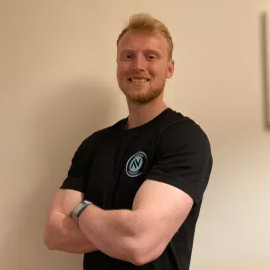A flexibility expert says these are the three moves she would recommend doing "every single day"
She swears by this simple five-minute routine


Most days, the majority of us have at least one part of the body that feels stiff and sore. But a flexibility expert says just a short dose of daily stretching has helped her keep these aches and pains at bay, and it can help you too.
"Try to have a small daily stretching routine," advises Elma Panagaki, a 500-hour certified yoga instructor based at Bay Club El Segundo. "Usually we want 20 minutes—I do it, and after feeling the difference it’s made I now never leave it out.
"If you can’t spare 20 minutes, let’s find 10 minutes, or even five minutes, just to focus on yourself."
For those pressed for time, she recommends the five-minute routine below as a speedy way to get your flexibility fix.
How to do Elma Panagaki’s three-move stretching routine
A post shared by Ruth Gaukrodger (@ruthgaukrodger)
A photo posted by on
- Shoulder and chest stretch to forward fold x60 seconds
- Deep squat to forward fold x60 seconds
- Low lunge to half-split x60 seconds on each side
Perform the moves above in order while "listening to your body", says Panagaki. This means if you want to ease off a stretch, cut it short or hold it for longer when it’s feeling good, then do. You can scroll down for a detailed breakdown of how to do each one with demo images from our fitness editor Ruth Gaukrodger, or watch her video above.
"It’s also more important to focus on mobility, rather than just flexibility," Panagaki adds. "Flexibility is half of mobility, but mobility involves being flexible and strong with a full range of motion [in our joints]. That’s why I love movement."
Aim to transition slowly and smoothly between the moves, holding each one for a few seconds, or longer if prescribed. Continue this for the allotted time, breathing deeply throughout.
Start your week with achievable workout ideas, health tips and wellbeing advice in your inbox.
1. Shoulder and chest stretch to forward fold


- Stand upright and interlace your fingers behind you with your knuckles facing down.
- Roll your shoulder blades back and down, pulling your hands towards the ground, to feel the stretch in your chest.
- Keeping your spine long, hinge at the hips to lean your torso forward until it’s almost parallel to the ground. Bring your interlaced hands overhead.
- Reverse this motion to return to standing.
- Hold each position for a few deep breaths and alternate between the two for roughly one minute.
Benefits of this stretch
"If I had to choose one stretch for the rest of my life, this is the one.I do it every single day," says Panagaki.
"You’re going to feel the stretch in your shoulders and also across your chest. This is good for posture, and when we say that we’re talking about having a neutral spine with all its natural curves."
Panagaki says maintaining good posture can prevent lower-back pain and do your confidence the world of good.
"This is about body language too," she says. "When we feel stressed, we bring our shoulders forward to protect our heart and chest. We deal with stress every day and unfortunately there’s not always anything we can do about that. But we can control what we do while we’re here. Opening the chest helps to build confidence."
2. Deep squat to forward fold


- If you have a yoga mat, stand upright at the top of the mat with your feet at either edge, toes pointed out slightly.
- Push your hips back and bend your knees to come into a deep squat position. Keep a neutral spine—don’t round your back.
- If you are unable to sit at the bottom of a squat comfortably, place a sturdy object like a couple of yoga blocks under your pelvis for support.
- Hold this position for 30 seconds, then slowly transition into a forward fold. Straighten your legs—or keep them softly bent if you have tight hamstrings—while keeping your torso close to your thighs. Hinge at the hips so your upper body hangs towards the floor.
- Hold this position for 30 seconds, then transition back to the deep squat.
- Complete this sequence twice, which should take two minutes.
Benefits of this stretch
"In yoga the Sanskrit term for a deep squat is Malasana, which means goddess pose," Panagaki says. "The deep squat stretches all the soft tissue—muscles, ligaments, everything—around your ankles, your knees and your hips."
Adding the transition to the forward fold helps develop a full range of motion in your lower body joints.
"This transition is a beautiful mobility exercise, and it’s definitely one of the things I think you should do every day. Or you can just stay in a deep squat—you don’t have to alternate if it doesn’t feel good.
"When you’re in a stretch and you feel pain or discomfort, you’re actually activating the muscles to go against the stretch. You want to relax there. Never push aggressively."
3. Low lunge to half-split


- Start in a high kneeling position, with your thighs and torso upright.
- Step forward with your right leg so your right ankle is directly beneath, or further forward than, your right knee.
- Slide your left knee back as far as you comfortably can, keeping your left shin against the floor, then extend your arms towards the ceiling. Hold this position for a few deep breaths.
- From here, sit back towards your back foot, straighten your right leg and flex the toes of your right foot. Keeping your spine long, lean forward towards your front foot and place your hands on the floor either side of your right leg for support. If this feels uncomfortable, you can place your hands on raised surfaces like yoga blocks or piles of books.
- Hold each position for a few deep breaths and continue to transition between them for one minute, then switch legs and repeat on the other side of your body.
Benefits of this stretch
"I love this one—Anjaneyasana—so much," says Panagaki.
"Usually when we have a lot of stress, you feel it in your shoulders and the hips. These are the things that we have to put a little bit extra focus into.
"This move is going to relax your hips and provide a beautiful stretch for your psoas. These are the hip muscles responsible for every movement of your legs—when you walk, every step starts from the psoas."
Adding the transition to the half-split has the added benefits of lengthening the spine and opening up the back of the leg, providing an enjoyable stretch for muscles like the hamstrings.
Panagaki also says this move, and all the positions in this routine, can help you destress.
"We’re not just stretching for flexibility, mobility and everything, it’s also for the mind. The more you stretch and breathe, the more you relax the mind and release that tension."
What to expect from daily stretching
While Panagaki is a huge advocate for daily stretching, she also warns people that change isn’t instant. You have to stick with it if you want to see results like improved mobility and fewer sore spots.
"You’re not going to go to a gym and do a pull-up on the first day, it’s all about practice," she says.
"All the stretches in the world take time [to have an effect]. You have to relax in the position and breathe. If you do it every day, you will see improvements."
So, I couldn’t resist asking, what sort of time frame are we looking at before we start to notice changes?
"You’re not going to be super flexible after the first week, but you are going to feel lighter," says Panagaki. "When you’re stretching, your blood flow is increased. That means more oxygen goes to your mind and to your muscles, that’s why it boosts your energy.
"That makes you feel happy, and if you feel happier you’re going to give it one more week."
Panagaki claims that a month of daily stretching will help you release stress, you will start seeing improvements in your flexibility and your body will start to “crave more stretches” thanks to their feel-good effect.
"The other area where you will notice a difference early on is lower-back pain," she adds. "After a month, if you are consistent, you’re going to feel so much better with your body. You may even experience less pain, and that is going to mean your sleep quality will improve."

Harry Bullmore is a Fitness Writer for Fit&Well and its sister site Coach, covering accessible home workouts, strength training session, and yoga routines. He joined the team from Hearst, where he reviewed products for Men's Health, Women's Health, and Runner's World. He is passionate about the physical and mental benefits of exercise, and splits his time between weightlifting, CrossFit, and gymnastics, which he does to build strength, boost his wellbeing, and have fun.
Harry is a NCTJ-qualified journalist, and has written for Vice, Learning Disability Today, and The Argus, where he was a crime, politics, and sports reporter for several UK regional and national newspapers.